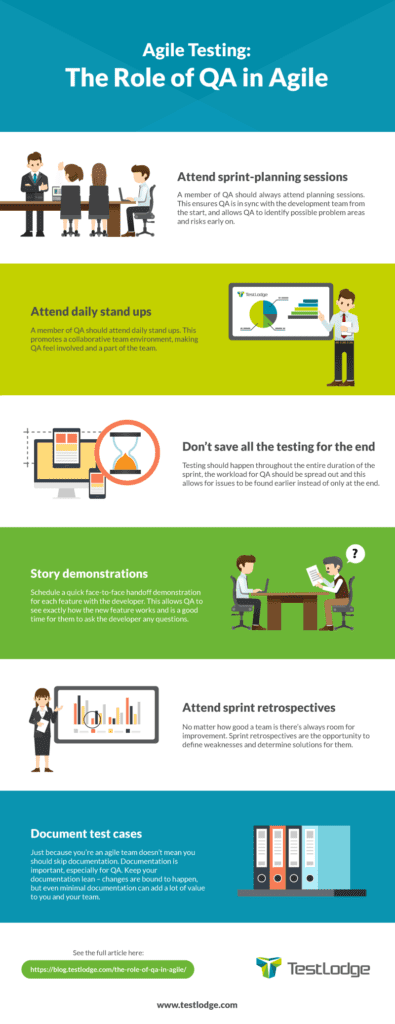We have talked about the benefits of integrating QA and Development in an agile environment in an earlier post and how removing boundaries between developers and testers promotes a collaborative working environment. When software testers and developers work in sync, they can produce higher-quality work in less time.

But what exactly is the role of QA in agile?
What can a tester do to help initiate a cooperative working relationship with the development team? Here are 6 things software testers should do when working with an agile scrum team:
1. Attend sprint planning sessions.
A member of QA should always attend planning sessions. Attending ensures QA is synchronized with the development team from the start and allows QA to identify possible problem areas and risks early on. Just like developers estimate the effort it will take for them to write code, QA should estimate the effort required for testing the code during the planning session. Without QA present, testing efforts and a realistic time allocation can be overlooked and not included in the sprint’s overall estimates.
2. Attend daily stand-ups.
A member of the QA team should always attend the daily stand-ups. Doing so promotes a collaborative team environment, making QA feel involved and a part of the team. Additionally, by QA being present, they can stay up to date with how the sprint is going, which allows them to plan their workload. If a tester has a blocker, they can bring this up during the stand-up. QA’s presence in stand-ups also gives them a chance to update on known issues, allowing developers to keep up to speed on testing progress and better plan their own workload.
3. Don’t save all the testing for the end; test throughout the sprint.
To deliver high-quality software in a short amount of time, you need to work efficiently. QA’s test workload takes place throughout the sprint, which allows for issues to be found earlier instead of only at the sprint’s conclusion. If you find all the bugs at the end of the sprint, it’s too late. Integrating testing and development allows the two teams to work together and resolve issues faster, leading to higher quality results.
4. Meet with developers for short, hand-off demonstrations.
It’s hard to argue against the value of in-person communication. Assuming QA and development work in the same location, schedule a quick face-to-face hand-off demonstration for each feature. Doing this allows QA to see precisely how the new feature works and is also a good time for them to ask the developer any questions. These hand-offs can also bring to light issues the developer may not have considered yet. These interactions also help shorten the feedback loop between development and QA
5. Attend sprint retrospectives.
Don’t miss out on the opportunity to discuss successes and failures that can improve future sprints by failing to attend the final team meeting. No matter how good a team is, there will always be room for improvement. Sprint retrospectives are the opportunity to define weaknesses and determine solutions for them. QA needs to be involved in these discussions to have any concerns addressed before the next sprint begins. For example, maybe a lot of the work was delivered to QA late in the sprint, leading to a rushed testing effort. QA might raise this concern to avoid it happening again the next time.
6. Document test cases.
Just because you’re an agile team doesn’t mean you should skip documentation. Documentation is essential, especially for QA. Keep your documentation lean because changes are bound to happen. Even minimal documentation can add a lot of value to you and your team. For example, if testers shift from project to project, having some test documentation will help get the new team member up to speed faster. QA and Development in an agile environment can help with this – we’ve built a lightweight tool to help you keep your test documents organized.
In summary, agile embraces lean, flexible processes, tools, and documentation. The traditional QA model is now a delivery-driven role requiring a collaborative environment. There QA can focus on tasks that result in one thing: quickly delivering a high-quality product.
Share as Infographic
Share these practical tips on how QA can work in an agile team with our infographic.
You can download the full-sized infographic here or use the embed code at the bottom of this post.
About the writer
Jake Bartlett
Jake Bartlett lives and works in Nashville, Tennessee. He has a background in software testing, customer support, and project management.
All Jake Bartlett's articles

